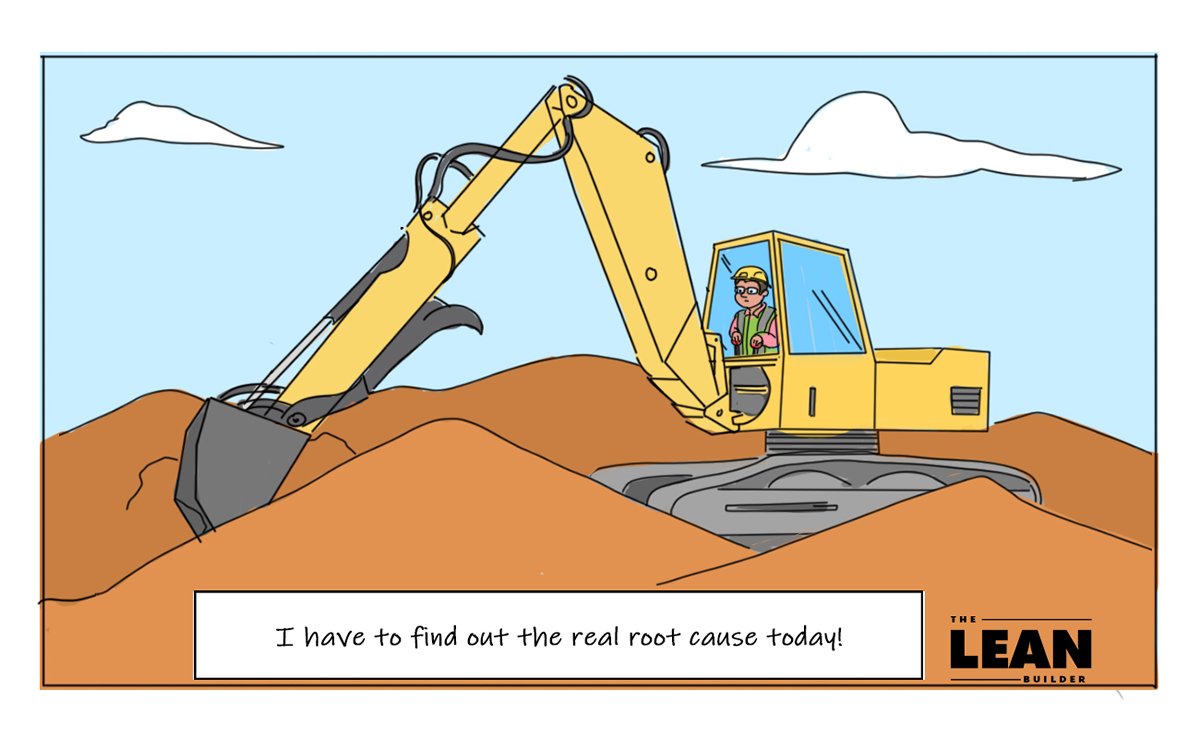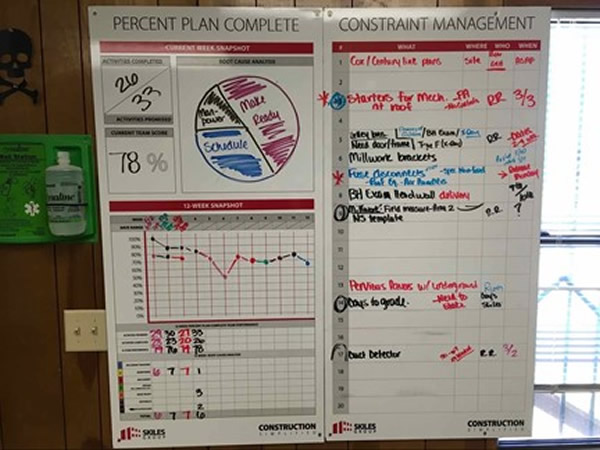Root cause analysis is another key element on your journey in Lean construction using The Last Planner® System. In this blog Lean expert Keyan Zandy explains some of the root causes for missed commitments in construction projects and also provides three tips to help you gain the maximum value from Root Cause Analysis on your jobsite.
What is root cause analysis?
If you have been following along with The Lean Builder, you know that we recommend running The Last Planner® System (or LPS) visually, with a set of Lean dashboards and a daily huddle routine, as outlined below:
Look-Ahead Planning
Before your Monday daily huddle, have your trades write the activities they intend to complete that week on a whiteboard. As a field leader, you should be asking the following questions:
- Are all the activities workable?
- Will all trades understand what is required?
- Will all trades understand what is needed from others?
- Are activities achievable within the planned period?
- Are the activities and durations reflective of what was committed to at the pull plan?
If the answer is no to any of these questions, collaborate with the trade partner and determine if they need to revise what has been written. When the board has been completely and correctly populated, you will be ready for Monday’s daily huddle.
Every day at the huddle, ask each last planner to read what activities they are working on and state what current manpower they have for implementing it. Have them show the team on the visual communication board.
On Fridays, the last planners reveal to the team whether they’ve met their commitments for that week, and this leads us to scoring.
Percent Plan Complete Scoring
On Friday’s huddle, ask each last planner if their work commitments are complete. If the answer is yes, write a Y next to the activity; if the answer is no, then an N goes next to the activity. When grading the Weekly Work Plan to establish the PPC score, remember the answer is either yes or no; there is no gray area.
Make Percent Plan Complete Visual
The benefit of making a visual Percent Plan Complete board is that it serves as a tool to help everyone stay on the same page at the daily huddle. (Read this blog post on scorekeeping to understand why.) You can build your Percent Plan Complete board with the following categories:
- Activities Completed
- Activities Promised
- Weekly Team Percentage
- Root Cause Categories
- Root Causes for Work Missed
- Twelve-Week Snapshot
Filling Out & Implementing the Percent Plan Complete Dashboard
After Friday’s huddle, tally up the number of activities completed and divide by the number of the activities promised. This will yield a percentage of commitments met.
Remember: The Percent Plan Complete score is not a reflection of production. It is the score of how well the team is making commitments to one another.
This is an important lesson that will take some longer than others to learn.
Monitor the entire team’s score rather than the individual trade partner’s scores. Perfection—100%—is not the goal, because a high score is not necessarily good news. Here’s why: if your team’s score is consistently in the mid- to high-ninetieth percentile, the team is not challenging itself to an acceptable level or they are not writing activities on the board that tie back to the pull plan/critical path.
The Percent Plan Complete board can be printed on plotter paper or drawn onto a whiteboard; either way, it should be displayed where you have your daily huddles.
Knowing the weekly percentage of commitments that the team has made is a great metric, but understanding the reason—the root causes—for the missed commitments is more important.
Root Causes
The predetermined root causes for missed commitments we use are:
- weather;
- manpower;
- machinery;
- design;
- make-ready;
- materials;
- poor scheduling; and
- other.
Root Cause Analysis Tips
If you are looking to gain the maximum value from Root Cause Analysis on your jobsite here are three tips to follow:
1. Dig Deeper
Sometimes the real reason for a commitment being missed is more than the surface level reason provided by the trade foreman. One way to find out is to implement a process called “5 Why”. Here is the layman’s version of “The 5 Whys”: when trying to understand a root cause onsite, ask “Why” five times to get to the core of the problem. For example, one morning during our huddle, we pulled our earthwork trade partner to the side and asked him the following string of questions related to his commitment failure that week. His equipment had failed, something that is typical on every jobsite, and he did not get the pad built for the concrete trade partner to start drilling piers. But was there something we could do to prevent this in the future?
- Why was the commitment missed?
Earthwork trade partner: My excavator broke down.
- Why?
Earthwork trade partner: Turns out the battery was dead.
- Why?
Earthwork trade partner: Well, the shop said the alternator crapped out.
- Why?
Earthwork trade partner: I don’t know, something about the alternator belt. It broke.
- Why?
Earthwork trade partner: Sheepishly, turns out the equipment hadn’t been maintained according to the recommended service schedule.
2. Do something about it
It’s one thing to identify the root cause, but it is another to do something about it. It turned out that quite a bit of the equipment hadn’t been serviced per the manufacturer’s recommendations. Our team had all equipment removed from the project that hadn’t been serviced per the manufacturer’s recommendations and only allowed it back onsite once it had been serviced. Not all root causes for commitments missed will work like this, but it’s important that after the Friday huddle is over, the team follow up on every missed commitment with an email, phone call, or both. For example, if work is delayed because a submittal wasn’t returned and now material is missing, then the root cause is design. A follow-up would be a call to the design team along with an email to try to resolve the issue.
3. Monitor the metrics
On our PPC boards, we keep a rolling 12-week snapshot capturing Percent Plan Complete and root causes for commitments missed. It is essential to pay attention to these metrics week to week to see if there are trends. For example, if you notice that the root cause “materials” keeps coming up for certain trade partners, then you will have better awareness that there may be issues around procurement that need to be dealt with right away. If you monitor results project after project, you will understand which root causes tend to come up the most and if there are buffers or better processes that can be put into place to improve upon these results.
The Percent Plan Complete (PPC) / Root Cause Analysis portion of the Last Planner System is often overlooked by many project teams who think of the Last Planner System as an à la carte menu—selecting a little pull planning here and a little look-ahead planning there. However, the Last Planner System is not designed in this manner. It is a holistic system, and Percent Plan Complete happens to be one of the most important parts of the Last Planner System, as it is the learning opportunity, the chance to get better as a team and shore up the commitments to be more reliable. Start slow and small and, in no time, you will see a lot more accountability around commitments on your jobsite.











